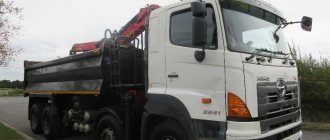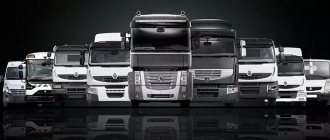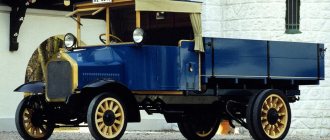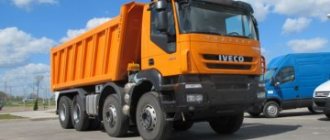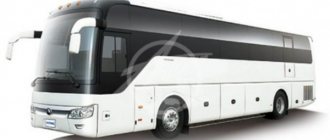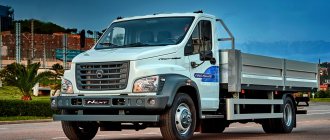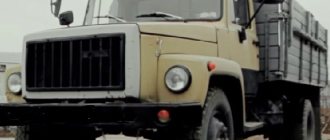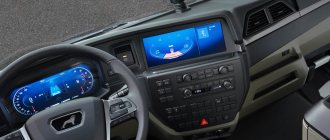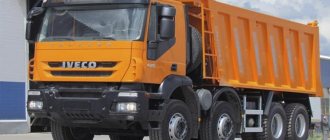The company's specialization is high-capacity vehicles for severe road and climatic operating conditions, essentially occupying an intermediate position between mainline tractors and mining dump trucks. All its models (trademark - “Yarovit”) are built on a modular principle. The model range consists of three families: with a cabin over the engine (“Gloros”), with a hood layout (“Dogmus”) and with a cabin in front of the engine (“Ordex”). The main wheel formulas are 6 x 6, 8 x 8, 10 x 8, but simplified options are also available (6 x 4, 8 x 6, 8 x 4, 10 x 6) with different arrangements of driving and driven axles.
Vehicle production began with a cab-over-engine family designed for use in various industries, on public roads, industrial roads and off-road conditions. The modules for Gloros are units and units produced by leading global companies in their fields.
In particular, the power units of the cars are Deutz diesel engines (V-shaped six-cylinder, displacement 11.9 and 15.9 liters, power 330 and 440 kW, or 449 and 598 hp), Cummins (in-line six-cylinder - wood-burning, 11-liter, power 250-317 kW, or 340-430 hp), "Caterpillar" (in-line six-cylinder, 12-liter, power 246-271 kW, or 335-505 hp). The package of any of them may include a pre-heater “Thermo 90S”.
Cars, depending on their purpose, are equipped with Alli-Son gearboxes. "Eton". Thus, for vehicles operating with heavy loads at low speeds, ZF-Friedrichshafen mechanical 16-speed gearboxes are intended (maximum torque - 2.2-1.1 kN • m). Among the eight models and modifications of gearboxes it offers, there are options with a built-in hydraulic brake-retarder (retarder), which allows you to relieve the braking system of cars and road trains when operating on mountain roads, and hydraulic couplings that ensure high smoothness of shifting without a significant (compared to GMT) reduction Efficiency For operating conditions that require frequent gear changes with minimal power interruption time, six-speed Allison HD4560 automatic transmissions (maximum torque -2.1 kN • m) with or without power take-offs, retarder (four modifications in total) are used.
Transfer cases on cars of the Gloros family - or JSC Yarovit Motors. All of them are mechanical two-stage, designed to transmit a torque of 25 kN • m (mod. ZF-VG2000) and 30 kN • m (ZF-VG2700 and “Yarovit”). Moreover, the box of our own production turned out to be much lighter than the imported analogue (380 kg versus 450).
Modifications and configurations of the family vehicles will be equipped with driving and driven axles and Exceltek, which are also used on heavy equipment DAF, Volvo, Sisu, Jinaf, etc. For example, it purchases a non-driving, steered axle from Yarovit , driving steered and through steered axles, designed for a load of 10 tons; driving unsteered axles, as well as driving bogies from two (tandem) and three (tridem) axles, each of which is capable of carrying a load of 13 or 16 tons (depending on the modification). The drive axle ratios are 4.65, 5.56 or 6.36.
supplies Yarovit with non-driven steered axles designed for a load of 11.6 and 10 tons, a driven steered axle - for 10, a steered tandem - for 20, unsteered tandems - for 26 and 32, a tridem - for 55 tons. Their gear ratios are 4 .63, 5.05 or 5.6.
The supporting system of Gloros vehicles is a frame, which consists of side members manufactured by the French division from cold-resistant Domex steel (developed by SSAB), cross members and reinforcements assembled using high-strength flange self-locking bolts (strength class 10.9).
The car suspension is of a traditional design: spring, with telescopic shock absorbers and anti-roll bar. Springs - small leaf, supplied, etc.; shock absorbers - “Grip” and “Monroe” (they simultaneously serve as rebound limiters on the rear axles).
The Gloros steering is a rather complex but reliable hydraulic system, which consists of two isolated circuits and maintains controllability of the vehicle in the event of failure of either its individual elements (pumps, valves and cylinders are duplicated) or depressurization of one of the circuits. The system also remains operational when the engine suddenly stops and the chassis is towed with the engine turned off, since the pumps are driven not only from the engine, but also from the chassis wheels. Steering mechanisms for the Gloros are supplied by the Lenksystem department.
For braking, cars of the family, in addition to the working one, have an additional and emergency parking system.
The service brakes are dual-circuit pneumatic.
The brake mechanisms are drum brakes with automatic clearance adjustment; their design is such that it prevents water and dust from getting on the working surfaces. The pneumatic system is equipped with coarse and fine filters and an air dryer, ensuring reliable operation of the brakes at low temperatures and longevity of the system. All cars are equipped with ABS with a maximum speed limit function (the ABS controller is connected to the engine management system). Indicator Yarovit Gloros vehicles
Type b x b 8 x 8 10 x 8 8 x 6 chassis chassis chassis dump truck Vehicle weight, t: gross* 35/41 44/50 59/68 50 curb 10.3 12.4 14.4 17.2 Load capacity*, t 24.7/30.7 31.6/37.6 44.6/53.0 32.7 Permissible total weight of the road train, t 62 72 200 — Overall dimensions, mm: length 6950 8200 9560 9000 width 2550 2550 2550 2550 height 3200 3200 3200 3300 Base, mm 3400+1400 1700+2980+1400+1400 1700+2980+1400 1700+3100+1400 Mounting frame length (body length ), mm 4.5-5.0 5.75-6.25 7.56 6.0 Loading (mounting) height, mm 1250 1250 1250 1550 Body volume, m3 — — — 21 Engine: power, kW (hp) 300(408)/317( 425) 400(544) 300(408)/317(425) torque, N • m 1960/2100 2350 1960/2100 Gearbox: number of stages 16 16 16 16 range of gear ratios 13.8-0.84 13.8 -0.84 13.8-0.84 13.8-0.84 Transfer case: number of stages 2 2 2 2 gear ratios 1.522 and O.826; 1.536 and 0.89 or 1.536 and 0.89 Drive axles: load capacity (rear), t 13/16 13/16 13/16 16 gear ratios 4.65 4.65/5.56 5.56/6.36 5 ,56 Tires: front axles 385/65R22.5(160J)/12.00R24(160K) I2.00R24 12.00R24 rear bogie 315/80R22.5(156K)/12.00R24(160K) I2.00R24 12.00R24 Maximum speed, km /h0 Fuel capacity, l 400 400 400 400 or 500 •When the maximum speed is limited (60 km/h), the load capacity and total weight of the 6x6 and 8x8 t chassis can be increased by 3 and 4 tons, respectively. Additional braking system - motor brake with pneumatic drive; emergency and parking braking - due to spring energy accumulators.
Four standard sizes of double cabins have been developed for the family, differing in height and length. At the same time, in the low short one, intended mainly for construction equipment, one folding berth is provided, in the low extended one - increased comfort - one (stationary) berth; in the high short and extended ones, which are equipped with cars for transporting heavy bulky cargo over long distances, there are two berths.
All cabins are frame-panel: fiberglass external and internal panels are glued onto a welded metal frame, and the space between them is filled with polyurethane foam. This design provides comfortable working conditions for the driver in both hot and cold climates.
The base of the cabin is designed in a similar way, which makes it possible to effectively isolate its interior from noise and heat.
All cab versions have a suspension consisting of four springs with built-in shock absorbers, but upon request, the cab suspension can be replaced with pneumatic one.
Thanks to the large glass area, the driver has a good view, and double-glazed windows (the “northern configuration” option) allow it to be preserved at the lowest ambient temperatures. Taking into account the large size of the windshield, the designers have provided for the possibility of replacing it, at the consumer’s request, with a composite one made of two parts.
The cabin heating and ventilation system includes, in addition to the main heater, an independent low-noise air heater "Air Top-2000" and an air conditioning system.
On the dashboard, a special place is given to switches and indicators for the inclusion of differential locks. Moreover, when the differentials of the front axles are blocked, a special alarm is turned on, warning of a decrease in the controllability of the vehicle. There is also an electronic display on the panel, which displays information from the standard tachograph, which can be replaced with a digital one (mandatory in EU countries since 08.2004), for which the speed measurement system has appropriate outputs.
As you can see, Yarovit cars are designed from very reliable and expensive components, so, naturally, they cannot be cheap. However, the company is ready to compete with the products of other manufacturers: the quality level of cars of the new families will be completely different from those of similar domestic vehicles, and the price will be significantly lower than that of foreign analogues. Moreover, it will certainly decrease. First of all, due to mastering the assembly of a number of necessary components on the territory of Russia (together with the companies that develop these components).
Alive, smoking room!
The history of the TONAR truck cabin is very trivial. Initially, Chinese Shanxi cabs were used on Tonar trucks under the MAN F2000 license, since designing, let alone manufacturing, such a complex and certified component as a cab on your own is expensive and unprofitable with an annual demand of one hundred units. Naturally, they were purchased from Chinese licensees.
New cabs from Hubei Qixing Truck & Cabin Manufacturing Co., Ltd are supplied by a Chinese partner. But the abundance of ashtrays is simply surprising! Here I remembered a joke about Chinese quality: a sign of the need to replace a car is the filling of the ashtray (in the 1920s, this joke was told about the Ford T, and since the 1960s it has been relevant for Japanese small cars and British cars).
But with such an abundance of ashtrays and the decision of the State Duma of the Russian Federation to ban smoking in the workplace, this dump truck is destined for a long life! For example, I don’t smoke...
On and off roads
From the first meters of movement, it became clear that when moving, the car is perceived much better than in a static position. The twenty-five-ton monster reacts quite sensitively to steering movements despite the long wheelbase, and the gearbox indulges in clear shifts. And here is a mound of rubble, behind which there is a deep spring rut. Oops! All of our wheeled equipment is now in use and is in a variety of positions and levels, but the dump truck is moving steadily! Then there was a series of experiments with plains, dirt, rough terrain, several dashing circles around the site and maneuvers in reverse. I was pleased. There is no place left for Sinophobia! Steering axles on transverse distortions compensate for the assertiveness of the leading rear tandem bogie. By the way, the softer the soil, the higher the steering effect. But these maneuvers take some getting used to.
The turning radius is, of course, large in relation to a standard truck of similar dimensions, but not so large as to be wary of looking around a narrow area. You need to be able to use it to your advantage. Otherwise, the car seems to have been born for large-scale European renovations. Maybe this was the reason for the failure of similar clumsy off-road “Yarovit Gloros”, which the designers developed for difficult cases, and the managers used almost for harvesting? A successful car should have no contradictions!
The first-born of the new model returned to the plant after testing in the Kemerovo region
An empty Tonar does not tend to roll, and its maneuverability by eye is only suitable for general-purpose road traffic (i.e., satisfactory on a grader). The braking of passively steered 2nd and 3rd axles must always be taken into account. Taken together, this sets the operating conditions - technologically equipped roads with hard surfaces, suitable for the movement of heavy and mining dump trucks with a reduced coefficient of adhesion weight, reaching up to 0.4.
“Comments” for authorities...
In accordance with clause 1.2. Appendix No. 4 to the Technical Regulations on the safety of wheeled vehicles (approved by Decree of the Government of the Russian Federation of September 10, 2009 No. 720 as amended by Decrees of the Government of the Russian Federation of September 10, 2010 No. 706 and dated October 6, 2011 No. 824): “When measuring the width, the following devices mounted on the vehicle are not taken into account:” ... “tarp fastening devices and elements of their protection.”
The body is designed for a transported material density of 0.9–1.3 t/m3, but is not designed for the primary development of clay and sand quarries. Taking into account the lining of the dump truck and chassis, this is a good ratio for quarries and processing complexes operating on the far side, where cross-country ability is not a decisive factor.
